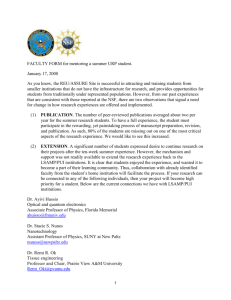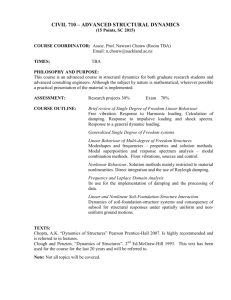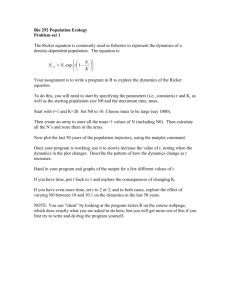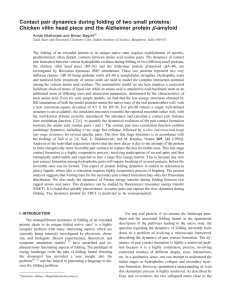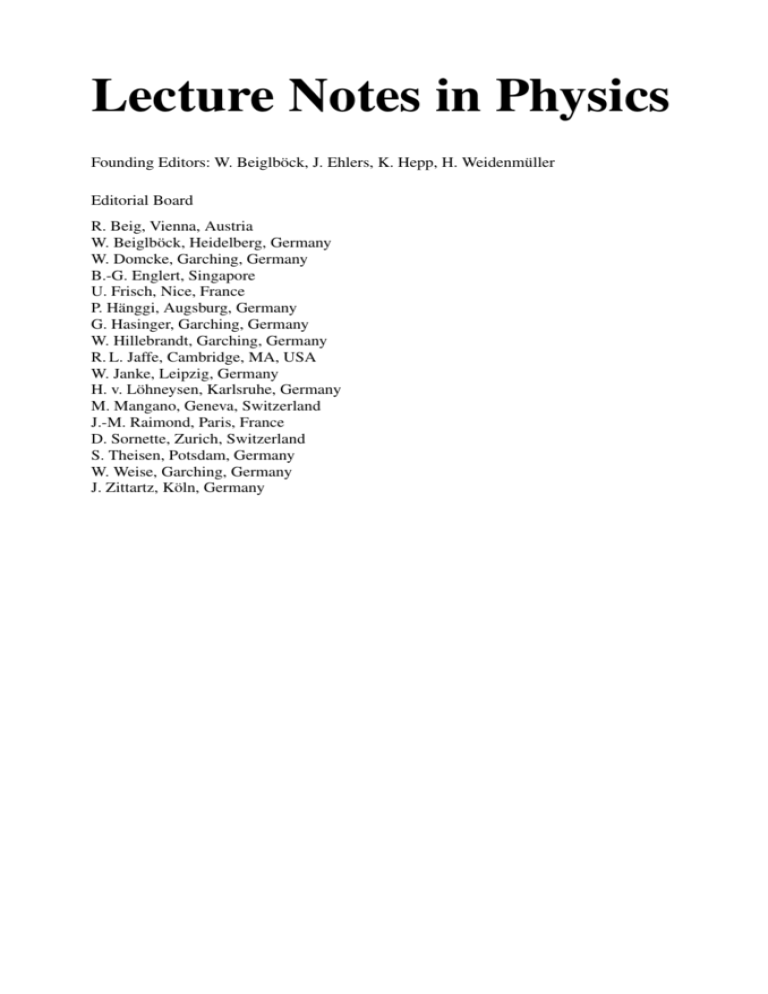
Lecture Notes in Physics
Founding Editors: W. Beiglböck, J. Ehlers, K. Hepp, H. Weidenmüller
Editorial Board
R. Beig, Vienna, Austria
W. Beiglböck, Heidelberg, Germany
W. Domcke, Garching, Germany
B.-G. Englert, Singapore
U. Frisch, Nice, France
P. Hänggi, Augsburg, Germany
G. Hasinger, Garching, Germany
W. Hillebrandt, Garching, Germany
R. L. Jaffe, Cambridge, MA, USA
W. Janke, Leipzig, Germany
H. v. Löhneysen, Karlsruhe, Germany
M. Mangano, Geneva, Switzerland
J.-M. Raimond, Paris, France
D. Sornette, Zurich, Switzerland
S. Theisen, Potsdam, Germany
W. Weise, Garching, Germany
J. Zittartz, Köln, Germany
The Lecture Notes in Physics
The series Lecture Notes in Physics (LNP), founded in 1969, reports new developments
in physics research and teaching – quickly and informally, but with a high quality and
the explicit aim to summarize and communicate current knowledge in an accessible way.
Books published in this series are conceived as bridging material between advanced graduate textbooks and the forefront of research and to serve three purposes:
• to be a compact and modern up-to-date source of reference on a well-defined topic
• to serve as an accessible introduction to the field to postgraduate students and
nonspecialist researchers from related areas
• to be a source of advanced teaching material for specialized seminars, courses and
schools
Both monographs and multi-author volumes will be considered for publication. Edited
volumes should, however, consist of a very limited number of contributions only. Proceedings will not be considered for LNP.
Volumes published in LNP are disseminated both in print and in electronic formats, the
electronic archive being available at springerlink.com. The series content is indexed, abstracted and referenced by many abstracting and information services, bibliographic networks, subscription agencies, library networks, and consortia.
Proposals should be sent to a member of the Editorial Board, or directly to the managing
editor at Springer:
Christian Caron
Springer Heidelberg
Physics Editorial Department I
Tiergartenstrasse 17
69121 Heidelberg / Germany
christian.caron@springer.com
G. Franzese
M. Rubi (Eds.)
Aspects of Physical Biology
Biological Water, Protein Solutions,
Transport and Replication
123
Giancarlo Franzese
Universidad Barcelona
Fac. Fisica
Depto. Fisica Fonamental
Marti i Franquesa, 1
08028 Barcelona
Spain
gfranzese@ub.es
Miguel Rubi
Dept. Fisica Fonamental
Fac. Fisica
Marti i Franquesa, 1
08028 Barcelona
Spain
mrubi@ub.edu
Franzese, G., Rubi, M. (Eds.), Aspects of Physical Biology: Biological Water, Protein
Solutions, Transport and Replication, Lect. Notes Phys. 752 (Springer, Berlin Heidelberg
2008), DOI 10.1007/978-3-540-78765-5
ISBN: 978-3-540-78764-8
e-ISBN: 978-3-540-78765-5
DOI 10.1007/978-3-540-78765-5
Lecture Notes in Physics ISSN: 0075-8450
Library of Congress Control Number: 2008928566
c 2008 Springer-Verlag Berlin Heidelberg
This work is subject to copyright. All rights are reserved, whether the whole or part of the material is
concerned, specifically the rights of translation, reprinting, reuse of illustrations, recitation, broadcasting,
reproduction on microfilm or in any other way, and storage in data banks. Duplication of this publication
or parts thereof is permitted only under the provisions of the German Copyright Law of September 9,
1965, in its current version, and permission for use must always be obtained from Springer. Violations are
liable to prosecution under the German Copyright Law.
The use of general descriptive names, registered names, trademarks, etc. in this publication does not imply,
even in the absence of a specific statement, that such names are exempt from the relevant protective laws
and regulations and therefore free for general use.
Cover design: eStudio Calamar S.L., F. Steinen-Broo, Pau/Girona, Spain
Printed on acid-free paper
9 8 7 6 5 4 3 2 1
springer.com
Preface
The application to Biology of the methodologies developed in Physics is attracting an increasing interest in the scientific community. The physics approach to the
study of biological problems has created the new interdisciplinary field of Physical
Biology. The aim of this field is to reach a better understanding of the biological
mechanisms at the molecular and cellular levels. Statistical Mechanics plays an important role in the development of this new field.
For this reason, we selected as topic and title for the XX Sitges Conference
on Statistical Physics “Physical Biology: from Molecular Interactions to Cellular
Behavior.” As is by now tradition for the Sitges conferences, a number of lectures
were subsequently selected, expanded and an updated for publication in the series
“Lecture Notes in Physics” to provide both an introduction and an overview to
a number of subjects of broader interest and to favor the interchange and crossfertilization of ideas between biologists and physicists. This volume focuses on
three main subtopics: biological water, protein solutions, and transport and replication, presenting for each of them the ongoing debates on the recent results. The
role of water in biological processes, the mechanisms of protein folding, the phases
and cooperative effects in biological solutions, and the thermodynamic description
of replication, transport and neural activity are all subjects that in this volume are
revised, based on new experiments and new theoretical interpretations.
The conference itself was held in Sitges (Barcelona, Spain) on 5–9 June, 2006,
and was sponsored by several institutions that provided financial support: European
Physical Society, Ministerio de Educación y Ciencia of the Spanish Government,
Departament d’Universitats, Recerca i Societat de la Informació of the Generalitat
de Catalunya, Universitat de Barcelona and the Centre Especial de Recerca (CER)
Fı́sica de Sistemes Complexos. As in former editions of the conference, the city of
Sitges allowed us to use the beautiful Palau Maricel as the lecture hall. We are also
very grateful to M. Naspreda, whose contribution as member of the Local Organizing Committee was essential, and to M.-C. Miguel, D. Reguera and J. M. Vilar for
their helpful suggestions. Last but not least, we would like to thank all the speakers
and participants of the conference, for the high scientific quality of their contributions and for the pleasant atmosphere that they created, and in particular those
vi
Preface
colleagues who agreed to the effort of providing tutorial accounts of their lectures
that make up this exciting volume.
Barcelona,
December 2007
Giancarlo Franzese
Miguel Rubi
Contents
Part I Biological Water
Dynamics of Water at Low Temperatures and Implications
for Biomolecules . . . . . . . . . . . . . . . . . . . . . . . . . . . . . . . . . . . . . . . . . . . . . . . .
P. Kumar, G. Franzese, S.V. Buldyrev and H.E. Stanley
1
Introduction . . . . . . . . . . . . . . . . . . . . . . . . . . . . . . . . . . . . . . . . . . . . . .
2
Bulk Water . . . . . . . . . . . . . . . . . . . . . . . . . . . . . . . . . . . . . . . . . . . . . . .
3
Hydrated Biomolecules . . . . . . . . . . . . . . . . . . . . . . . . . . . . . . . . . . . .
4
Other Evidences of Changes at the Widom Line . . . . . . . . . . . . . . . .
5
Relation Between Thermodynamics and Dynamics . . . . . . . . . . . . .
6
Conclusions . . . . . . . . . . . . . . . . . . . . . . . . . . . . . . . . . . . . . . . . . . . . . .
References . . . . . . . . . . . . . . . . . . . . . . . . . . . . . . . . . . . . . . . . . . . . . . . . . . . . .
Anomalous Behaviour of Supercooled Water and Its Implication
for Protein Dynamics . . . . . . . . . . . . . . . . . . . . . . . . . . . . . . . . . . . . . . . . . . . .
J. Swenson, H. Jansson and R. Bergman
1
Introduction . . . . . . . . . . . . . . . . . . . . . . . . . . . . . . . . . . . . . . . . . . . . . .
2
Apparent Fragile to Strong Transitions of Confined
Supercooled Water . . . . . . . . . . . . . . . . . . . . . . . . . . . . . . . . . . . . . . . .
3
Relation Between Solvent and Protein Dynamics . . . . . . . . . . . . . . .
4
Conclusions . . . . . . . . . . . . . . . . . . . . . . . . . . . . . . . . . . . . . . . . . . . . . .
References . . . . . . . . . . . . . . . . . . . . . . . . . . . . . . . . . . . . . . . . . . . . . . . . . . . . .
Interactions of Polarizable Media in Water
and the Hydrophobic Interaction . . . . . . . . . . . . . . . . . . . . . . . . . . . . . . . . . .
F. Bresme and A. Wynveen
1
Introduction . . . . . . . . . . . . . . . . . . . . . . . . . . . . . . . . . . . . . . . . . . . . . .
2
The Origin of Strong Attraction Between Hydrophobic Surfaces . .
3
Computer Simulation Treatment of Polarizable
Hydrophobic Solutes . . . . . . . . . . . . . . . . . . . . . . . . . . . . . . . . . . . . . .
4
The Influence of Solute Polarizability
on the Hydrophobic Interaction . . . . . . . . . . . . . . . . . . . . . . . . . . . . . .
3
4
9
11
13
14
19
20
23
23
28
32
38
39
43
43
46
51
56
viii
Contents
5
Outlook . . . . . . . . . . . . . . . . . . . . . . . . . . . . . . . . . . . . . . . . . . . . . . . . . 59
References . . . . . . . . . . . . . . . . . . . . . . . . . . . . . . . . . . . . . . . . . . . . . . . . . . . . . 61
Part II Protein and Biological Solutions
Metastable Mesoscopic Phases in Concentrated Protein Solutions . . . . . . .
P.G. Vekilov, W. Pan, O. Gliko, P. Katsonis and O. Galkin
1
Macroscopic and Mesoscopic Phases . . . . . . . . . . . . . . . . . . . . . . . . .
2
Methods of Detection and Monitoring of Metastable Clusters . . . .
3
Intermolecular Interactions in Solutions of Lumazine
Synthase and Hemoglobin . . . . . . . . . . . . . . . . . . . . . . . . . . . . . . . . . .
4
Lack of Liquid–Liquid Phase Separation in Solutions
of Lumazine Synthase and Hemoglobin . . . . . . . . . . . . . . . . . . . . . . .
5
Dense Liquid Clusters in Solutions of Lumazine Synthase
and Hemoglobin . . . . . . . . . . . . . . . . . . . . . . . . . . . . . . . . . . . . . . . . . .
6
Monte Carlo Simulations of Formation and Decay of Clusters . . . .
7
Summary and Perspectives for Future Work . . . . . . . . . . . . . . . . . . .
References . . . . . . . . . . . . . . . . . . . . . . . . . . . . . . . . . . . . . . . . . . . . . . . . . . . . .
65
66
69
74
75
76
87
90
91
Application of Discrete Molecular Dynamics to Protein Folding
and Aggregation . . . . . . . . . . . . . . . . . . . . . . . . . . . . . . . . . . . . . . . . . . . . . . . . 97
S.V. Buldyrev
1
Introduction . . . . . . . . . . . . . . . . . . . . . . . . . . . . . . . . . . . . . . . . . . . . . . 97
2
Discrete Molecular Dynamics . . . . . . . . . . . . . . . . . . . . . . . . . . . . . . . 98
3
Protein Folding . . . . . . . . . . . . . . . . . . . . . . . . . . . . . . . . . . . . . . . . . . . 102
4
The One-Bead Go Model . . . . . . . . . . . . . . . . . . . . . . . . . . . . . . . . . . . 102
5
Transition States of Realistic Proteins . . . . . . . . . . . . . . . . . . . . . . . . 107
6
The Two-Bead Go Model . . . . . . . . . . . . . . . . . . . . . . . . . . . . . . . . . . 110
7
The Two-Bead Model with Hydrogen Bonds:
Studies of Protein Aggregation . . . . . . . . . . . . . . . . . . . . . . . . . . . . . . 112
8
The Four-Bead Model: Studies of the α -Helix-to-β -Hairpin
Transition . . . . . . . . . . . . . . . . . . . . . . . . . . . . . . . . . . . . . . . . . . . . . . . . 114
9
Simulations of Amino Acid–Specific Interactions . . . . . . . . . . . . . . 120
References . . . . . . . . . . . . . . . . . . . . . . . . . . . . . . . . . . . . . . . . . . . . . . . . . . . . . 128
Cooperative Effects in Biological Suspensions: From Filaments
to Propellers . . . . . . . . . . . . . . . . . . . . . . . . . . . . . . . . . . . . . . . . . . . . . . . . . . . . 133
I. Pagonabarraga and I. Llopis
1
Introduction . . . . . . . . . . . . . . . . . . . . . . . . . . . . . . . . . . . . . . . . . . . . . . 133
2
Semiflexible Filaments . . . . . . . . . . . . . . . . . . . . . . . . . . . . . . . . . . . . . 135
3
Modeling Inextensible Semiflexible Filaments . . . . . . . . . . . . . . . . . 135
4
Semiflexible Filaments Under External Forcing . . . . . . . . . . . . . . . . 138
5
Self-Propelling Particles . . . . . . . . . . . . . . . . . . . . . . . . . . . . . . . . . . . 141
6
Short-Time Dynamics . . . . . . . . . . . . . . . . . . . . . . . . . . . . . . . . . . . . . 143
7
Long-Time Dynamics . . . . . . . . . . . . . . . . . . . . . . . . . . . . . . . . . . . . . . 145
8
Conclusions . . . . . . . . . . . . . . . . . . . . . . . . . . . . . . . . . . . . . . . . . . . . . . 150
References . . . . . . . . . . . . . . . . . . . . . . . . . . . . . . . . . . . . . . . . . . . . . . . . . . . . . 151
Contents
ix
Part III Transport and Replication
A Thermodynamic Description of Active Transport . . . . . . . . . . . . . . . . . . . 155
S. Kjelstrup, J.M. Rubi and D. Bedeaux
1
Introduction . . . . . . . . . . . . . . . . . . . . . . . . . . . . . . . . . . . . . . . . . . . . . . 155
2
Energy Conversion in the Ca-ATPase . . . . . . . . . . . . . . . . . . . . . . . . . 156
3
Towards a Thermodynamic Transport Theory . . . . . . . . . . . . . . . . . . 160
4
Mesoscopic Non-equilibrium Thermodynamics . . . . . . . . . . . . . . . . 163
5
Experimental Determination of Transport Coefficients . . . . . . . . . . 170
6
Conclusion . . . . . . . . . . . . . . . . . . . . . . . . . . . . . . . . . . . . . . . . . . . . . . . 173
References . . . . . . . . . . . . . . . . . . . . . . . . . . . . . . . . . . . . . . . . . . . . . . . . . . . . . 173
Energy Interconversion in Transport ATPases . . . . . . . . . . . . . . . . . . . . . . . 175
L. de Meis
1
Introduction . . . . . . . . . . . . . . . . . . . . . . . . . . . . . . . . . . . . . . . . . . . . . . 175
2
Concepts in Energy Transduction . . . . . . . . . . . . . . . . . . . . . . . . . . . . 177
3
Phosphate Compounds of High and Low Energy . . . . . . . . . . . . . . . 177
4
Experimental Measurements . . . . . . . . . . . . . . . . . . . . . . . . . . . . . . . 179
5
Energy Transduction by Enzymes: Conversion of Phosphate
Bonds from High into Low Energy at the Catalytic Site
of Enzymes . . . . . . . . . . . . . . . . . . . . . . . . . . . . . . . . . . . . . . . . . . . . . . 181
6
Energy Transduction and Heat Production in Transport ATPases . . 184
References . . . . . . . . . . . . . . . . . . . . . . . . . . . . . . . . . . . . . . . . . . . . . . . . . . . . . 185
A Novel Mechanism for Activator-Controlled Initiation of DNA
Replication that Resolves the Auto-regulation Sequestration Paradox . . . . 189
K. Nilsson and M. Ehrenberg
1
Introduction . . . . . . . . . . . . . . . . . . . . . . . . . . . . . . . . . . . . . . . . . . . . . . 190
2
Analysis . . . . . . . . . . . . . . . . . . . . . . . . . . . . . . . . . . . . . . . . . . . . . . . . . 198
3
Conclusions . . . . . . . . . . . . . . . . . . . . . . . . . . . . . . . . . . . . . . . . . . . . . . 210
References . . . . . . . . . . . . . . . . . . . . . . . . . . . . . . . . . . . . . . . . . . . . . . . . . . . . . 212
Activity-Dependent Model for Neuronal Avalanches . . . . . . . . . . . . . . . . . . 215
L. de Arcangelis
1
Introduction . . . . . . . . . . . . . . . . . . . . . . . . . . . . . . . . . . . . . . . . . . . . . . 215
2
Neurons, Synapses, and Hebbian Plasticity . . . . . . . . . . . . . . . . . . . 217
3
Neural Avalanches and Networks: Experimental Results . . . . . . . . . 219
4
The Model . . . . . . . . . . . . . . . . . . . . . . . . . . . . . . . . . . . . . . . . . . . . . . . 220
5
Pruning and Neuronal Avalanches . . . . . . . . . . . . . . . . . . . . . . . . . . . 222
6
Power Spectra . . . . . . . . . . . . . . . . . . . . . . . . . . . . . . . . . . . . . . . . . . . . 225
7
Conclusions . . . . . . . . . . . . . . . . . . . . . . . . . . . . . . . . . . . . . . . . . . . . . . 228
References . . . . . . . . . . . . . . . . . . . . . . . . . . . . . . . . . . . . . . . . . . . . . . . . . . . . . 229
Index . . . . . . . . . . . . . . . . . . . . . . . . . . . . . . . . . . . . . . . . . . . . . . . . . . . . . . . . . . . . . 231
Index
1/ f noise, 227
Φ values, 110
β -amyloid, 114, 120, 121
β -relaxation, 24
action potential, 217, 218, 220, 221
activation energy, 20
activation energy, 7, 8, 10, 17, 18
active transport, 156, 167
available energy, 157
work done, 157
aggregate, 146–150
alignment, 145, 150
Alzheimer disease, 114, 121, 122
Alzheimer’s disease, 97, 113, 121
amyloidogenesis, 119
Arrhenius, 24
Arrhenius behavior, 7–10, 12, 13, 17, 19
atomic force microscopy, 48
available work, 159
ballistic, 145, 146, 148
barnase, 104, 111, 112
bead-on-a-string model, 102
Berendsen barostat, 128
Berendsen method, 126
binary tree, 124
biofilament, 135, 138, 151
biological channels, 47
biological relevance of water, 3
biological water, 26
bulk water, 6
bulk water, 5
bulk water, 6, 8, 9, 14, 17, 19
Ca-ATPase, 156
cavitation, 46
chemical driving force, 166
chemical reactions, 100
cold denaturation, 101
computer simulations, 51
confined geometry, 26
confined water, 6–9, 17–19, 29
contact angle, 56
cooperativity, 133, 135, 141, 143, 145, 150,
151
coupling at the surface, 162
Curie principle, 162
dewetting, 110
dielectric boundaries, 52
dielectric spectroscopy, 28
diffusion, 139, 145, 146, 148
discontinuous molecular dynamics, 98
driving force
chemical, 166, 170
osmotic, 166, 170
thermal, 166, 170
drying, 46
dynamic crossover, 8, 19
dynamic crossover, 3, 4, 6–14, 16–18, 20
EEG, 216, 224–226, 228, 229
electrostatic potential, 52
energy landscape, 27
entropy production, 159
generalised friction, 159
in surface, 164
of a chemical reaction, 159
of active transport, 164
of the ATP hydrolysis, 159
ohmic heat, 159
event-driven molecular dynamics, 98
excess variables, 162
232
Index
excitatory, 219, 222, 223, 225, 227
low-density liquid, 20
fibrils, 98, 112, 114, 119, 120
flocking, 147, 148, 150, 151
folding, 108
folding nucleus, 104, 108
folding pathway, 111, 112
folding pathways, 107, 109, 111
fragile, 25
fragile-to-strong transition, 26, 28
fragility, 25
Mad Cow disease, 97
maximal valence model, 100
maximum im response functions, 7
maximum in response functions, 3, 10
mean square displacement, 145, 146
mobility, 138, 139
molecular pump, 156
slip, 156, 158, 168
stoichiometric, 158
molten globule, 105, 109, 119
motility, 133, 142, 143
myoglobin, 33
glass, 100, 101, 103, 119
glass formers, 25
Go model, 103, 107, 111
heat capacity, 44
heat production
measurement, 165
Hebb, 219, 229
heteropolymer, 100, 102, 103
heteropolymers, 102
high-density liquid, 20
Hill diagrams, 161
homopolymer, 103
Huntington disease, 114
Huntington’s disease, 113, 121
hydration water, 13
hydration shell, 27
hydration water, 3, 6, 11–13, 19, 20
hydrodynamic interactions (HI), 133, 135–141,
143–151
hydrogen bond, 6, 15, 16, 20, 45
hydrophobic interaction, 43
hydrophobic surface, 46
image charges, 52
inextensible filament, 133, 135, 136, 151
inhibitory, 219, 225, 227, 228
interfacial water, 29
Jagla model, 99
Jagla solvent, 110
lattice-boltzmann (LB), 141
leakage, 227
level flow, 167
Leventhal paradox, 102, 104
liquid–liquid critical point, 6
liquid–liquid phase transitions, 99
liquid-liquid critical point, 3, 5, 8–10, 16, 20
local equilibrium, 163
lost work, 159
low density states, 57
nanobubbles, 46
native state, 97, 102
natural selection, 102
nematic, 149, 150
network, 215–217, 219–221, 223, 224,
226–228
neuron, 215, 217–222, 229
neuronal avalanches, 216, 219, 222
neurotransmitter, 216, 219
neutron reflectivity, 48
No man’s land, 26
non-Arrhenius behavior, 7–10, 13, 16–19
non-equilibrium thermodynamics
classical, 156
mesoscopic, 156
non-linear flux-force relations, 156, 161
Nuclear magnetic resonance, 44
Onsager relations
mesoscopic level, 166
organism, 133, 134, 142, 146, 148, 151
osmotic driving force, 166
P-fold analysis, 108, 110, 112
pair distribution function, 148
persistence length, 135
physical gels, 100
Picasso, 102
plasticity, 216, 217, 219–223, 228
polarizability, 50
polarizable solutes, 51
polyalanine, 114, 117, 119, 120
polyglutamine, 114, 119, 121
polymer collapse, 99
potential energy landscape, 102
power spectra, 216, 225, 226
PRIME model, 101, 115
prion diseases, 97, 113
propulsion, 134, 142, 143, 149
Index
233
propylene glycol, 28
protein glass transition, 20
protein aggregation, 97
protein dynamics, 6
Protein folding, 97
protein folding, 44
protein glass transition, 6
protein glass transition, 3, 4, 13
protein water interactions, 49
pruning, 221, 223, 224, 228
stoichiometric pump, 167
stress, 133, 135, 139–141, 146–148
Sum frequency spectroscopy, 44
supercooled water, 4, 6, 8, 26, 31
surface
autonomous system, 162
surface force apparatus, 48
suspension, 133, 142–151
symmetry break, 162
synapses, 216–218, 220–223, 225, 227–229
QENS, 28
quasielastic neutron scattering, 28
thermal driving force, 166
thermal fluctuations, 58
thermodynamic anomalies, 101
thermogenesis, 156, 169
thermogenesis coefficients, 172
threshold firing, 220
transition state ensemble, 108
transition state ensembles, 107
trp-cage miniprotein, 107, 120, 121
Ramachandran angles, 116, 117
reaction kinetics, 161
the degree of reaction, 161
refractory period, 218, 220, 221
Reynolds number, 134, 135, 146, 149
sedimentation, 137–141, 143
self-propelling, 133, 135, 141–144, 146, 147,
149
semiflexible filament, 133, 135, 136, 138, 140,
151
SH3 domain, 104, 107, 109–111, 113
singularity-free scenario, 5, 6, 16
small world, 224, 226, 228
SOC, 216, 220, 228
specific heat, 9
specific heat, 3, 5, 7, 10, 12
spontaneous activity, 220, 221, 225
staphylococcal protein A, 104
static head, 167
stochastic process, 161, 226
Velasquez, 102
velocity verlet, 137
virial theorem, 127
viscosity, 24
Vogel-Fulcher-Tammann, 24
water, 44
water anomalies, 3–6, 8, 9, 20
water dynamics, 26
Widom line, 3, 4, 6–9, 12–14, 16, 20
work, 159
x-rays, 48


